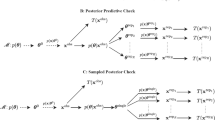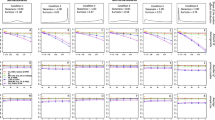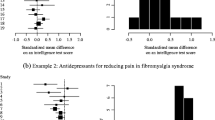Abstract
In meta-analysis model, due to the appearance of publication bias or outliers, as well as the small sample size, the normal assumption is usually unreliable. Therefore, the exploration of more robust estimation, such quantile regression (QR) method, is extremely important in meta-analysis area. This paper studies the QR estimation method in random-effects meta-analysis model based on the reformulation by asymmetric Laplace distribution (ALD). The maximum likelihood estimation using Monte Carlo Expectation Maximization algorithm and the Bayesian estimation using Markov chain Monte Carlo (MCMC) algorithm are proposed for computation of the QR estimates. The significance tests of regression coefficients are suggested using likelihood ratio statistics. For MCMC algorithm, a simple and efficient Gibbs sampling algorithm is employed based on a location-scale mixture representation of the ALD, and information criterions are considered for choosing the hyper-parameters. Monte Carlo simulations are conducted to study the finite sample performance of the proposed methodology and analysis of two real data sets are presented for illustrations. Our results show that QR estimation methods perform very well, especially in case of non-normal assumption in meta-regression models. The detailed algorithms and software code are available for easy use in applications.



Similar content being viewed by others
References
Aghamohammadi A, Mohammadi S (2017) Bayesian analysis of penalized quantile regression for longitudinal data. Stat Pap 58:1035–1053
Barndorff-Nielsen OE, Shephard N (2001) Non-Gaussian Ornstein–Uhlenbeck-based models and some of their uses in financial economics. J R Stat Soc Ser B (Stat Methodol) 63:167–241
Booth JG, Hobert JP (1999) Maximizing generalized linear mixed model likelihoods with an automated Monte Carlo EM algorithm. J R Stat Soc Ser B (Stat Methodol) 61:265–285
Chen Y, Hong C, Riley RD (2015) An alternative pseudolikelihood method for multivariate random-effects meta-analysis. Stat Med 34(3):361–380
Colditz GA, Brewer TF, Berkey CS, Wilson ME, Burdick E, Fineberg HV, Mosteller F (1994) Efficacy of BCG vaccine in the prevention of tuberculosis: meta-analysis of the published literature. J Am Med Assoc 271:698–702
Dagpunar JS (1989) An easily implemented generalised inverse Gaussian generator. Commun Stat Simul Comput 18(2):703–710
Dai X, Jin L, Tian M, Shi L (2019) Bayesian local influence for spatial autoregressive models with heteroscedasticity. Stat Pap 60:1423–1446
Devroye L (2014) Random variate generation for the generalized inverse Gaussian distribution. Stat Comput 24(2):239–246
Galarza CE, Castro LM, Louzada F, Lachos VH (2020) Quantile regression for nonlinear mixed effects models: a likelihood based perspective. Stat Pap 61:1281–1307
Galvao AF, Poirier A (2019) Quantile regression random effects. Ann Econ Stat 134:109–148
Geraci M, Bottai M (2007) Quantile regression for longitudinal data using the asymmetric Laplace distribution. Biostatistics 8(1):140–154
Hardy RJ, Thompson SG (1996) A likelihood approach to meta-analysis with random effects. Stat Med 15(6):619–629
Higgins JP, Thompson SG, Spiegelhalter DJ (2009) A re-evaluation of random-effects meta-analysis. J R Stat Soc A Stat Soc 172(1):137–159
Higgins JP, Whitehead A, Simmonds M (2011) Sequential methods for random-effects meta-analysis. Stat Med 30(9):903–921
Hobert JP, Casella G (1996) The effect of improper priors on Gibbs sampling in hierarchical linear mixed models. J Am Stat Assoc 91(436):1461–1473
Hörmann W, Leydold J, Derflinger G (2004) Automatic nonuniform random variate generation. Springer, Berlin
Hörmann W, Leydold J (2014) Generating generalized inverse Gaussian random variates. Stat Comput 24(4):547–557
Koenker R, Bassett G Jr (1978) Regression quantiles. Econometrica 46(1):33–50
Koenker R (2005) Quantile regression. Econometric society monograph series. Cambridge University Press, Cambridge
Kozumi H, Kobayashi G (2011) Gibbs sampling methods for Bayesian quantile regression. J Stat Comput Simul 81(11):1565–1578
Levine RA, Casella G (2001) Implementations of the Monte Carlo EM algorithm. J Comput Graph Stat 10(3):422–439
Leydold J, Hörmann W (2011) Generating generalized inverse Gaussian random variates by fast inversion. Comput Stat Data Anal 55(1):213–217
Liu Y, DeSantis SM, Chen Y (2018) Bayesian mixed treatment comparisons meta-analysis for correlated outcomes subject to reporting bias. J R Stat Soc Ser C (Appl Stat) 67(1):127–144
Luo Y, Lian H, Tian M (2012) Bayesian quantile regression for longitudinal data models. J Stat Comput Simul 82(11):1635–1649
Marino MF, Farcomeni A (2015) Linear quantile regression models for longitudinal experiments: an overview. Metron 73:229–247
Martino L, Míguez J (2011) A generalization of the adaptive rejection sampling algorithm. Stat Comput 21(4):633–647
Park JS, Qian GQ, Jun Y (2008) Monte Carlo EM algorithm in logistic linear models involving non-ignorable missing data. Appl Math Comput 197(1):440–450
Partlett C, Riley RD (2017) Random effects meta-analysis: coverage performance of 95% confidence and prediction intervals following REML estimation. Stat Med 36(2):301–317
Quintana FA, Liu JS, del Pino GE (1999) Monte Carlo EM with importance reweighting and its applications in random effects models. Comput Stat Data Anal 29(4):429–444
Robert CP, Casella G (2004) Monte Carlo statistical methods, 2nd edn. Springer, New York
Searle SR, Casella G, McCulloch CE (2009) Variance components. Wiley, Hoboken
Shi L, Zuo S, Yu D, Zhou X (2017) Influence diagnostics in meta-regression model. Res Synth Methods 8(3):343–354
Sidik K, Jonkman JN (2007) A comparison of heterogeneity variance estimators in combining results of studies. Stat Med 26(9):1964–1981
Sutton AJ, Higgins JP (2008) Recent developments in meta-analysis. Stat Med 27(5):625–650
Thompson SG, Sharp SJ (1999) Explaining heterogeneity in meta-analysis: a comparison of methods. Stat Med 18(20):2693–2708
Tian Y, Lian H, Tian M (2017) Bayesian composite quantile regression for linear mixed-effects models. Commun Stat Theory Methods 46(15):7717–7731
Van Houwelingen HC, Arends LR, Stijnen T (2002) Advanced methods in meta-analysis: multivariate approach and meta-regression. Stat Med 21(4):589–624
Viechtbauer W, Cheung MWL (2010) Outlier and influence diagnostics for meta-analysis. Res Synth Methods 1(2):112–125
Wang J (2012) Bayesian quantile regression for parametric nonlinear mixed effects models. Stat Methods Appl 21(3):279–295
Wang RW, Dunn DW, Luo J, He JZ, Shi L (2015) The importance of spatial heterogeneity and self-restraint on mutualism stability: a quantitative review. Sci Rep 5:14826
Whitehead A, Whitehead J (1991) A general parametric approach to the meta-analysis of randomized clinical trials. Stat Med 10(11):1665–1677
Yu K, Moyeed RA (2001) Bayesian quantile regression. Stat Probab Lett 54(4):437–447
Yuan Y, Yin G (2010) Bayesian quantile regression for longitudinal studies with nonignorable missing data. Biometrics 66(1):105–114
Yue YR, Rue H (2011) Bayesian inference for additive mixed quantile regression models. Comput Stat Data Anal 55(1):84–96
Acknowledgements
This research were supported by key project of National Natural Science Foundation (NSFC) of China (No. 11931015), and NSFC project (No. 11671348, No. 11801370, No. 12271471) and Shanghai Natural Science Foundation (No. 18ZR1427200).
Author information
Authors and Affiliations
Corresponding author
Ethics declarations
Conflict of interest
The authors declare no potential conflict of interests.
Additional information
Publisher's Note
Springer Nature remains neutral with regard to jurisdictional claims in published maps and institutional affiliations.
Rights and permissions
Springer Nature or its licensor holds exclusive rights to this article under a publishing agreement with the author(s) or other rightsholder(s); author self-archiving of the accepted manuscript version of this article is solely governed by the terms of such publishing agreement and applicable law.
About this article
Cite this article
Dai, X., Jin, L. & Shi, L. Quantile regression in random effects meta-analysis model. Stat Methods Appl 32, 469–492 (2023). https://doi.org/10.1007/s10260-022-00660-3
Accepted:
Published:
Issue Date:
DOI: https://doi.org/10.1007/s10260-022-00660-3




